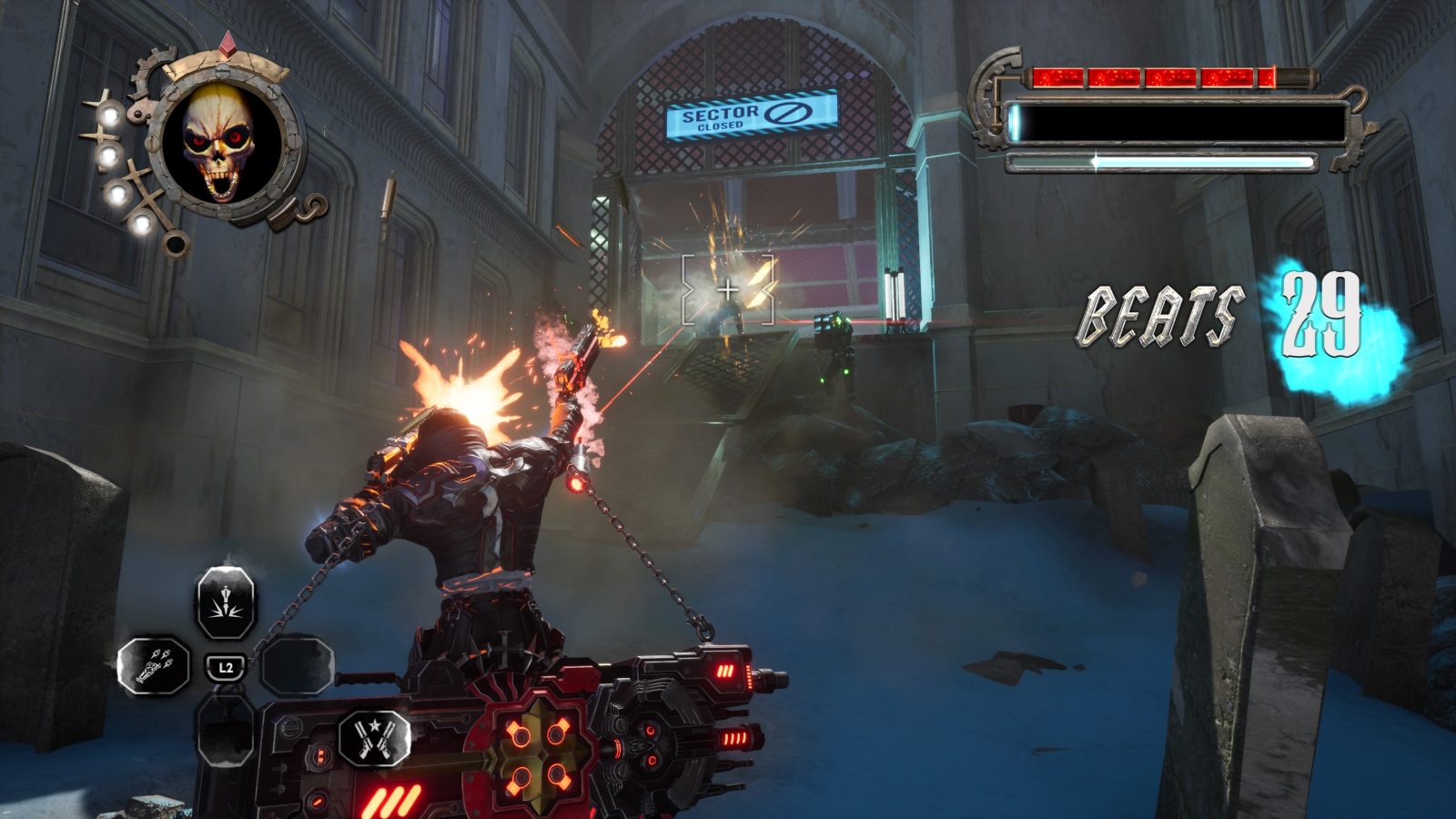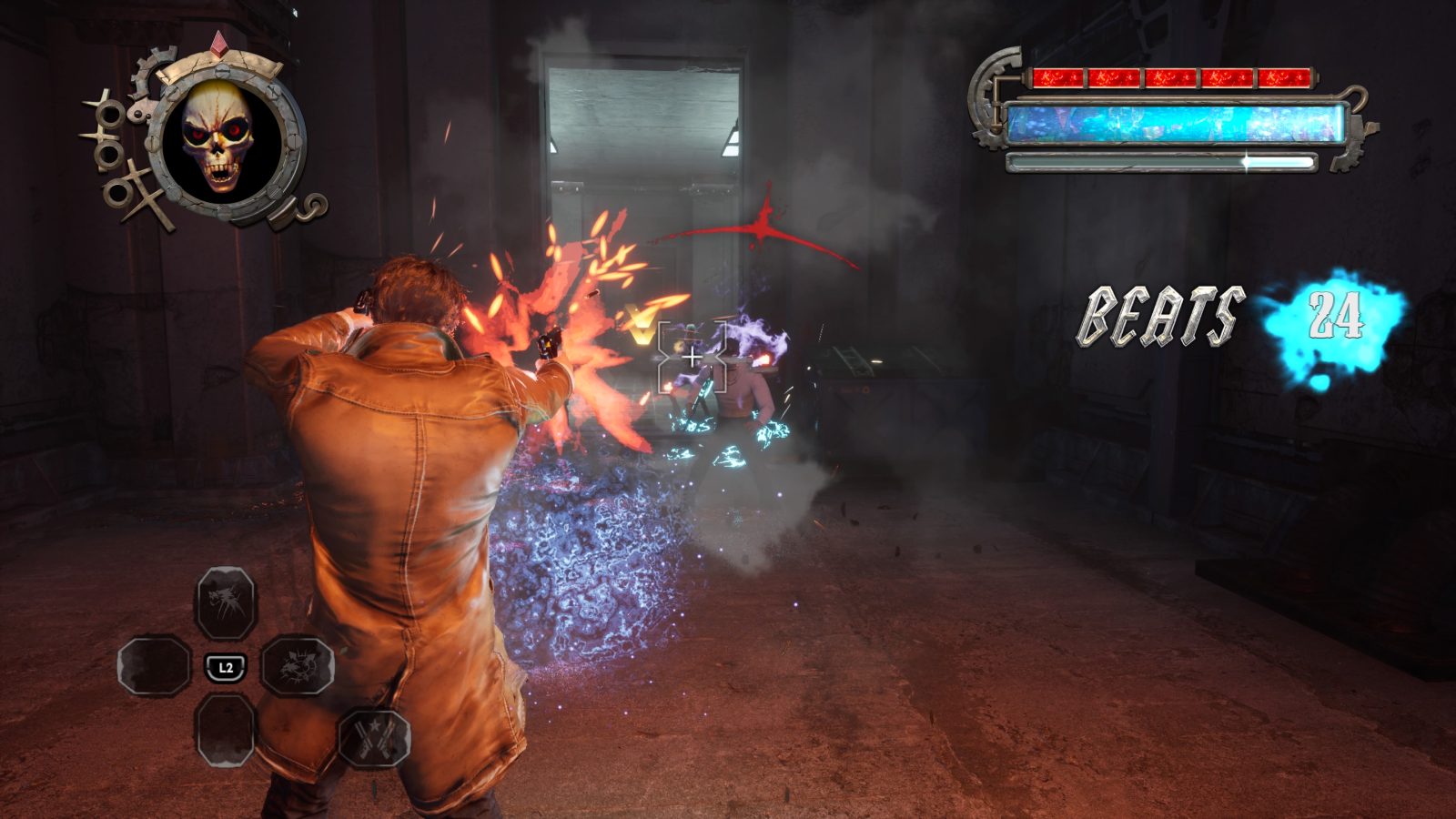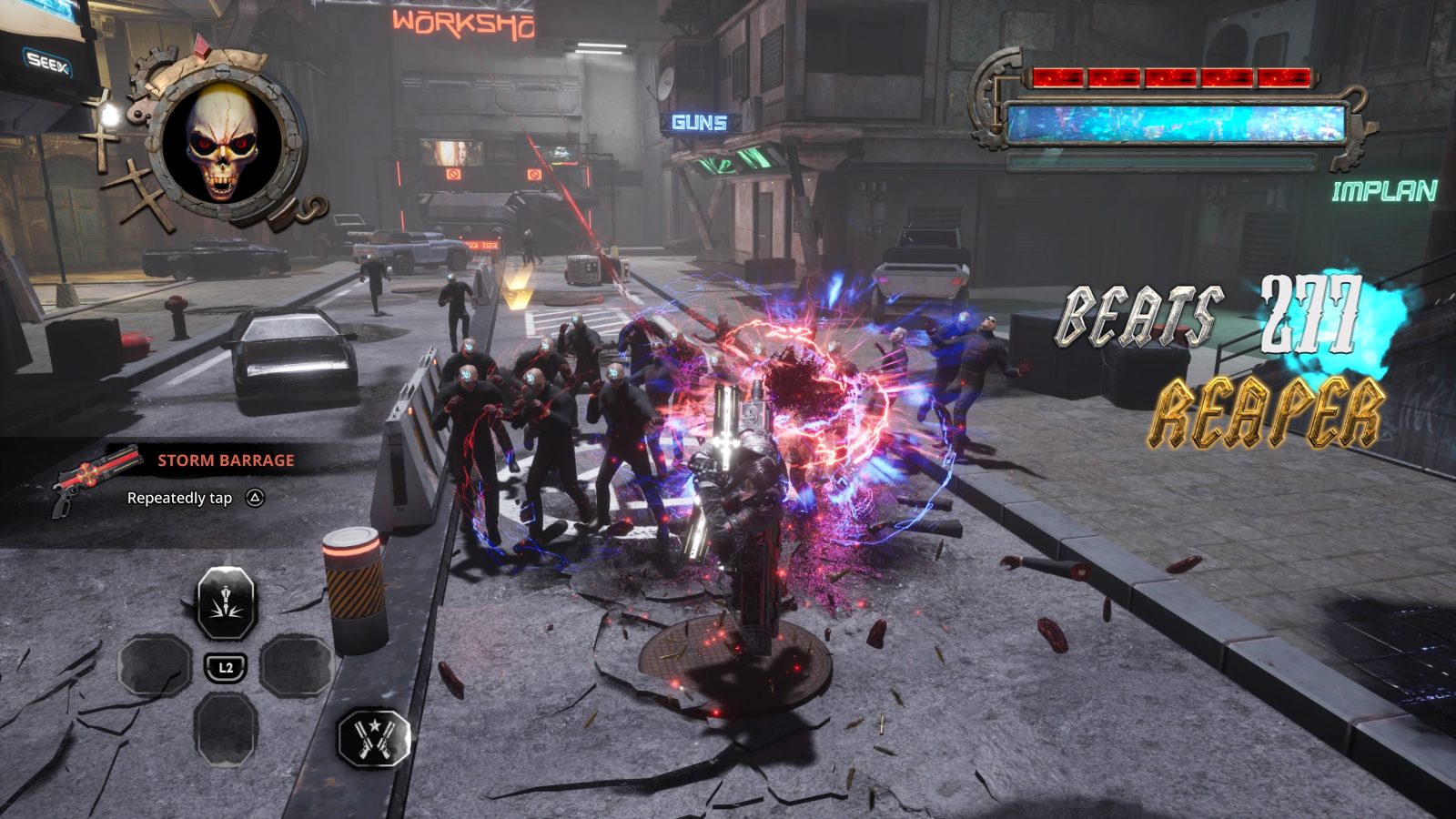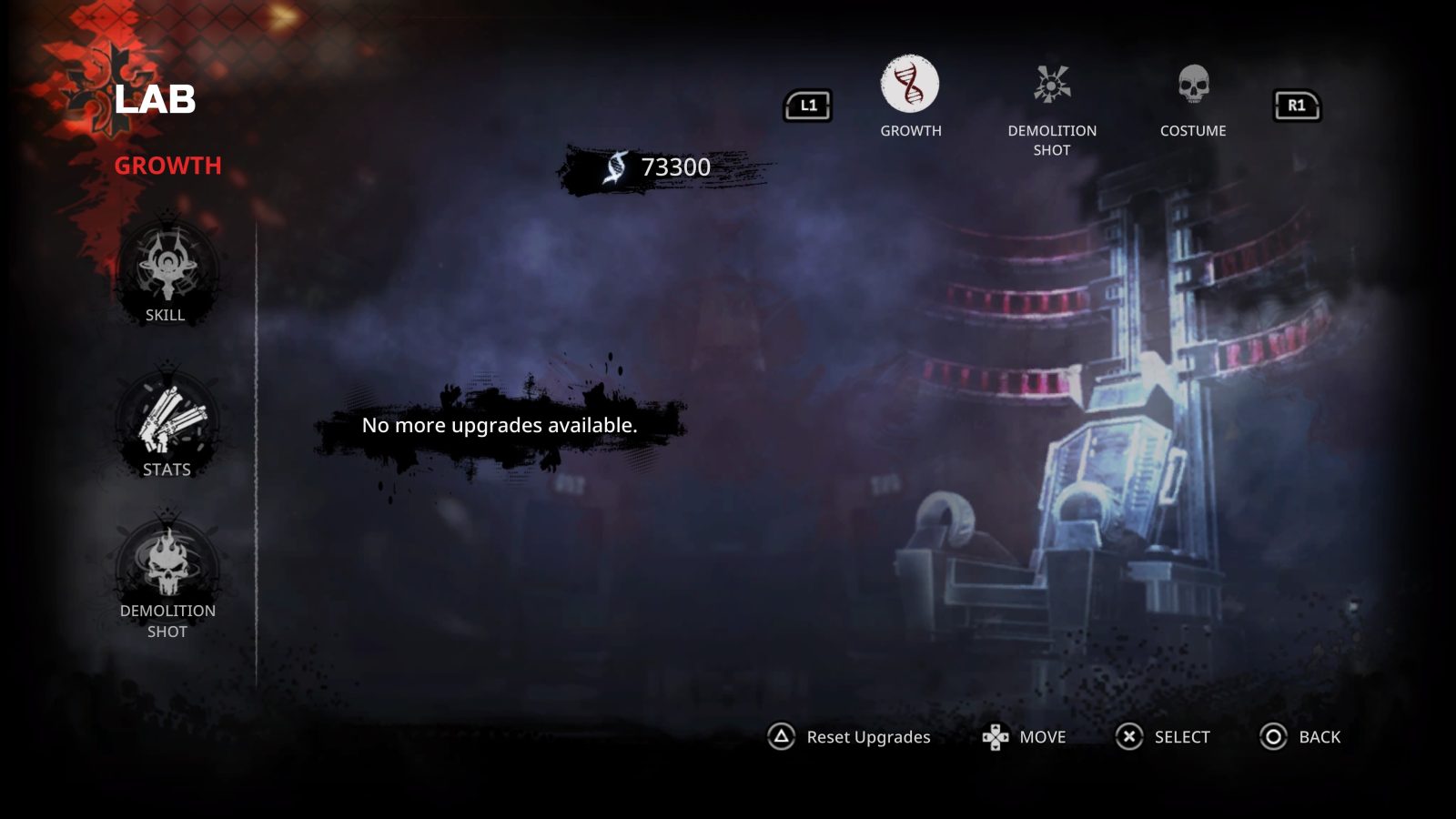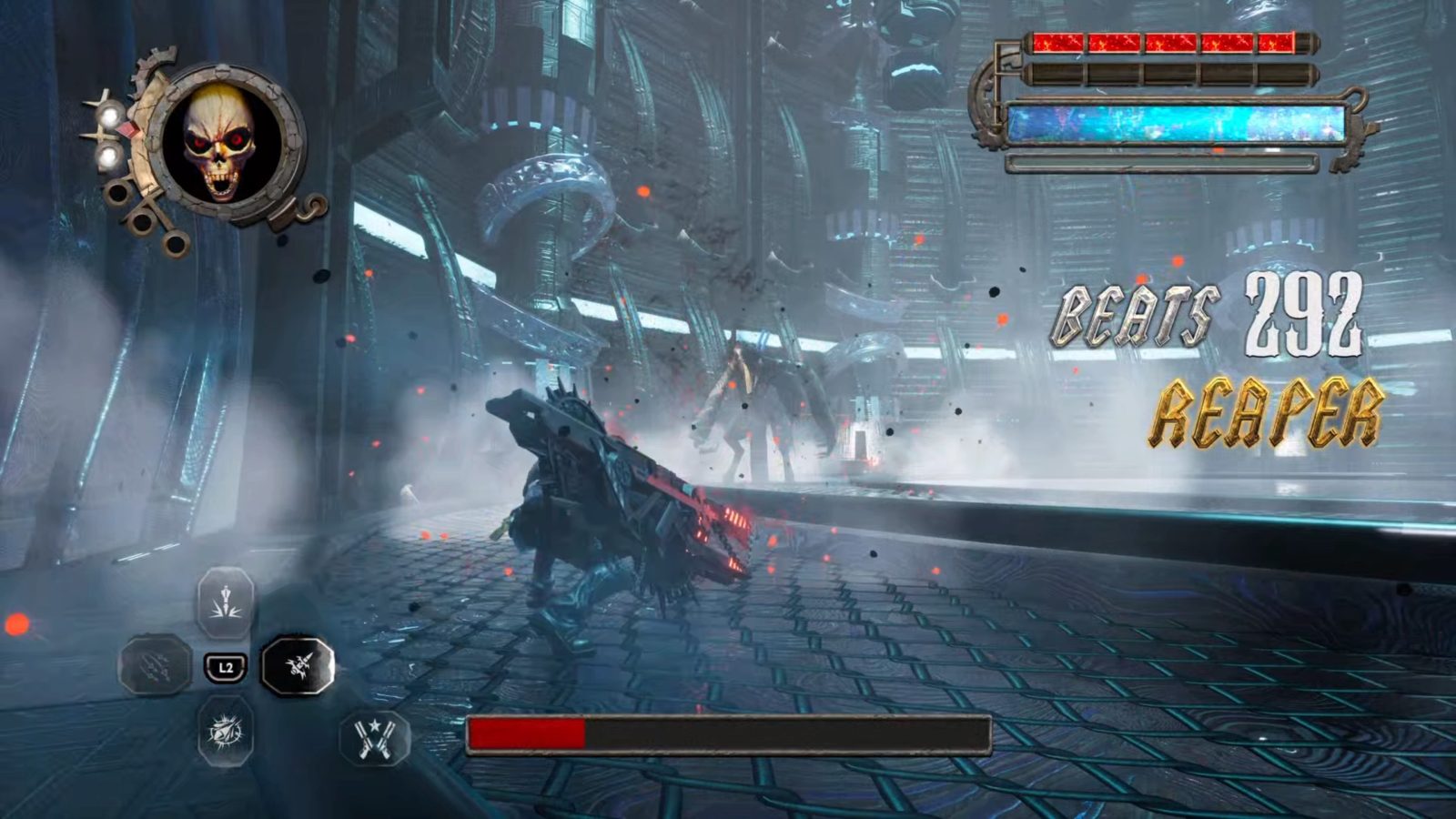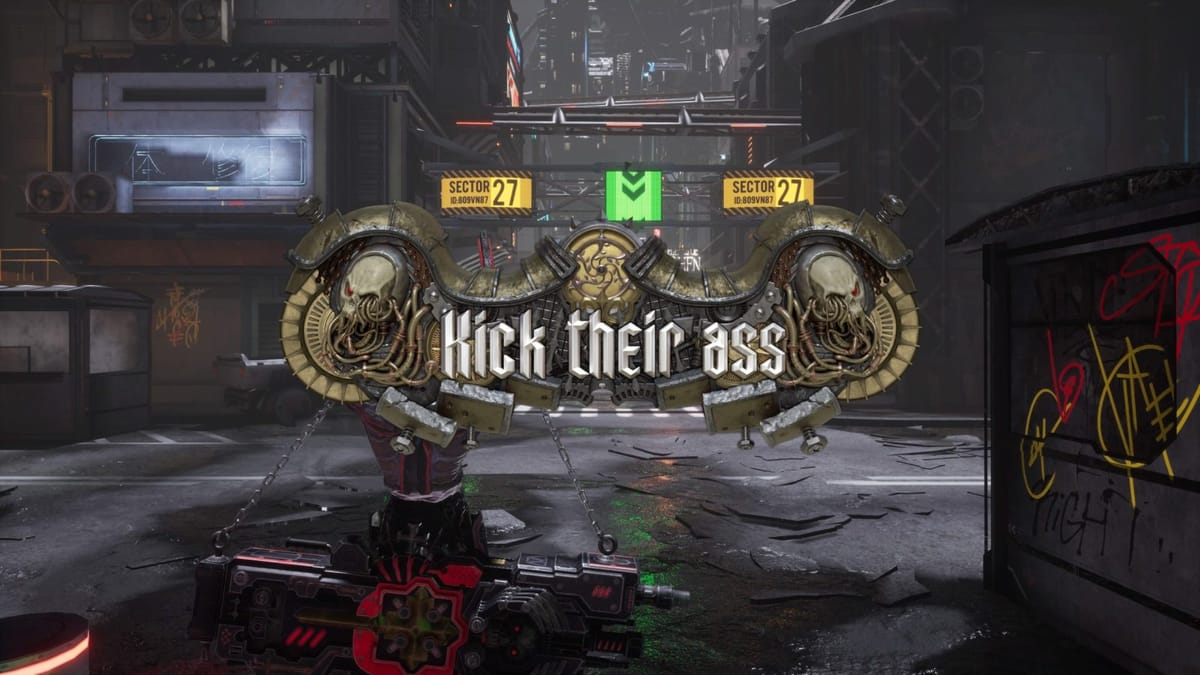
People often look down on simple games, but games don’t necessarily need a lot of depth to be fun. In fact, I find the absence of depth to be Gungrave’s greatest strength. The original Gungrave game unleashed a flurry of bullets and chaos that whipped up into a perfect storm of coolness. You shoot stuff in Gungrave, and that’s about all you do. I wouldn’t want it any other way. Simplicity forms the core of that game’s appeal, which makes the prospect of a sequel inherently complicated.
Sequels typically aim to add or expand an experience. By doing that, you risk ruining Gungrave. Gungrave already got one sequel that fell into this trap. While it has some merits, I’d say that the expansions that sequel gambled on didn’t pay off. Yet nearly twenty years later, Gungrave has risen from beyond the grave to once more to bet it all in the battle between simplicity and depth. These two philosophies pull Gungrave G.O.R.E. into wildly different directions, and the tears between the seams are noticeable. Yet for all its visible imperfections, I’d say that this time Gungrave emerges from the betting halls triumphant. This is a game for the Gungravers.
G.O.R.E. leaves the core appeal of Gungrave mostly untouched. The appeal, of course, is shooting. That’s what Gungrave does, and G.O.R.E. does it well. Part of the fun of shooting enemies comes from the style and impact of the act. I said that you shoot guys, but it may be more accurate to say that you obliterate them. Not just the bad guys, either; you obliterate nearly everything around you. Bullets tear through furniture, explode machinery, and shatter glass in a near constant barrage of destruction. If you base your game primarily on one mechanic, it needs to look and feel exciting to do, and G.O.R.E. nails this with stylish audio and visual feedback that lives up to the spirit of the original game.
Gungrave lives and dies on its style. Prior games took inspiration from anime and manga with stylized shading and thick outlines. They utilized jazzy compositions from the same composer as Trigun and Cowboy Bebop to sell the chaotic fun of the moment to moment gameplay. Gungrave is the action scenes of your favorite anime come to life, and it consistently looks and sounds the part. G.O.R.E. takes things in a noticeably different direction, with visuals that evoke a more realistic touch reminiscent of more recent CG anime movies. The soundtrack keeps the occasional bit of jazz, but adopts the action anthem approach of games like Devil May Cry. It even brings in the same composer from DMC! G.O.R.E. overhauls the visuals and sound, yet it still feels like Gungrave, which is to say it’s frenetic, fun, and stylish; all necessary elements for enhancing the admittedly simple gameplay.
I am oversimplifying the game a little bit. The “depth” of Gungrave shares a lot in common with arcade beat-em-up games. While you can technically treat them as mindless button mashers, you play them more efficiently by learning how to control crowds, prioritize threats, and approaching enemies with the right attacks. Gungrave adds its own twists with its “beat” system – for every bullet you land on an enemy or destructible object, you get one beat. It’s basically a combo system, but one you need to manage even after you’ve cleared out enemies by destroying objects. This system incentivizes you to continually press forward and pay attention to your surroundings. The “artistic” bonus caps off the scoring system by asking you to mix stylish kills into your otherwise steady pace.
For the original Gungrave, these two pillars held up the experience: it was fun to shoot things and it had some interesting scoring ideas that encouraged replays. Gungrave provides a little under two hours of stylish action and striking visuals and that’s perfectly fine in my book. Sequels would need to answer the question of how to evolve these ideas. Overdose, the immediate follow-up, placed a greater emphasis on story and more complex game design to mixed results. The sequel lacked a lot of the appeal of the original simply by weakening the purity of the action.
In contrast, G.O.R.E. brings things relatively back to basics. It tells a story, but there honestly isn’t much to it. More importantly, it rarely interrupts the game itself. G.O.R.E. retains most of the mechanical additions that Overdose brought to the table, but keeps the levels straightforward to navigate and focused on defeating enemies. G.O.R.E. samples Overdose’s idea and moves them into a game that better represents the core appeal of Gungrave. On paper, it’s exactly the kind of sequel I was hoping to see.
Rather than reinventing Gungrave, this game further builds on its mechanics. These new ideas fit surprisingly well into the straightforward game design. You can now grab enemies and use them to shield you from the always constant barrage of gunfire.They can either be pulled towards you or zipped over to, which grants some welcome mobility to your lumbering character. After taking damage, enemies can now enter into a stunned state. By running up to them or grabbing them from a distance, you can execute them. This serves a dual purpose of recharging your shield meter to keep you in the action longer while providing enough style to give you Art points. All of these additions supplement the core gameplay well without totally changing your approach.
The Storm Barrage mechanic impacts the game the most dramatically. Most other action games tend to push the player to avoid taking damage. In Gungrave, you are expected to tank bullets – that’s why you have a shield meter separate from your health. As long as you play skillfully enough, you will always be able to recharge your shield at the end of the firefight with most if not all your health intact. Storm Barrage pushes the expectation of damage one step further by encouraging you to take damage.
Upon activation, you begin firing shots wildly in all directions. This ends up being most effective when you are getting swarmed by enemies from all directions, which is the worst possible position you could be in while playing a Gungrave game. Storm Barrage turns this doomsday scenario into an opportunity. Unleashing it not only spreads damage across all of your attackers, it also rapidly fills your beat gauge for Demolition Shots. Demotion Shots act like super moves that do extra damage, but frankly their most vital utility lies in their secondary ability to restore your health. This means that you can use the Storm Barrage to quickly generate health, making up for whatever health you might be losing by jumping right into hordes of enemies.
In other words, Barrage Storm transforms you into a self-perpetuating energy source of bullets. This tactic allows for an extremely aggressive style of play unlike anything found in previous Gungrave games. Mechanical changes like Barrage Storm represent G.O.R.E. at its best: it brings ideas that work smoothly with what already exists in order to evolve the game in fun ways. When it comes to moment to moment gameplay, G.O.R.E. far exceeds its predecessors through these new additions.
Unfortunately, not every direction G.O.R.E. expands in fares so well. To be clear, none of the more suspect additions outright ruin the game. However, they did at several points make me ask “why, Gungrave?” Gungrave never responded directly, but I suspect that’s because Gungrave sensed that I already knew the answers in my heart.
Let’s start with the big one. G.O.R.E. sells upgrades that you can buy with points in between stages. While this concerns me, it is not a bad idea on its own. Optional stuff like melee skills or Demolition Shots make sense to lock behind a progression system; previous games already did that with Demolition Shots through other means. The presence of stat upgrades, however, confirms this as a bad idea for this particular game.
When you include stat upgrades for purchase, you have to consider how it affects game balance. This typically leads developers down one of two paths. On the preferable yet slightly nonsensical path, the game may be balanced around your starting abilities in order to account for the different choices you could make, so buying upgrades essentially makes you overpowered. In the more distressing path, the game expects you to be constantly upgrading your stats to keep up with the challenge of the game. This poses a problem in a shop environment, because the freedom of choice allows for the freedom to make the wrong choices.
To save you the suspense, G.O.R.E. takes the latter path. About four levels in, you find yourself on the top of a train. You have to reach the end of the train to escape colliding with a tunnel quickly coming up. Enemies predictably want to stop you from doing that, so the goal is to efficiently crush the bad guys and run to the end of the train in time.
I found this level to be extremely challenging – too challenging. It felt like the enemies were simply tanking too much damage for me to realistically make the cut. I eventually squeaked by after running past some of them, only to arrive at a very similar problem in the next level. This time the enemies were completely overwhelming me and I was unable to thin their numbers in a reasonable amount of time. Now there was no escaping the truth: I was too weak to properly handle this.
Although I started the game on “Normal” mode, the game clearly expected me to be much stronger than I was. I felt pretty stupid for putting points in anything except strength, yet this was also very early into the game. I could have technically just gone back and grinded my previously completed levels, but another thought occurred to me. G.O.R.E. lets you switch your difficulty freely between levels, and I began to wonder if the game actually wanted me to start on the difficulty I did at all.
I suspect that “Normal” might be misleading, and that the game actually intends for you to play through the “Easy” mode in order to build up your stats and then move up each tier of difficulty from there. What further confirms this in my eyes is that completing every level on each difficulty has a unique unlockable, and these rewards do not stack. The game expects you to complete each difficulty individually. So that’s what I did.
This may sound bad, and it is to an extent, yet I didn’t mind it entirely. This structure creates a situation where each subsequent playthrough becomes more fun than the last as you build up your arsenal of upgrades and begin to experiment. On Easy, I was playing the game like a normal Gungrave game with little deviation. I only discovered my Barrage Storm strategy near the end of my Normal playthrough, after I had purchased all of the extra skills for the move. I had the most fun with the game on hard mode because I was already as strong as my stats could get. Gungrave games intend for you to replay them, and forcing it in this manner is not necessarily a bad thing.
The main issue I take with this decision is that it communicates its intent extremely poorly. If you wanted me to start on Easy, you probably shouldn’t have called it Easy. Honestly, giving the player a choice at all seems questionable. If you present a choice, then it should be reasonable for a player to be able to complete the game on every difficulty based on skill alone. Ideally, the developers should remove stats from the shop menu. If a shop is needed, it should focus entirely on optional mechanics.
Other bad design decisions are less harmful and serve more as strange curiosities. Quick time events pop up in the first handful of levels, only to mysteriously disappear for the rest of the game, seemingly replaced with sporadic platforming segments. Platforming and Gungrave have never gotten along and they remain on bad terms. One level contains a hall full of lasers you need to roll through – if you get clipped, you are instantly killed. Scenarios like these are annoying and uncalled for, but their effects are admittedly diminished by the facts that they are infrequent and there’s virtually no penalty for dying. You are typically sent back just before the high stakes situation occurs, so little time is lost.
I understand the thought process behind these weaker inclusions. Modern games obsess over incentivizing the player to continue, and growing your character is a prominent way games do that now, hence the upgrade system. Selling a game that focuses entirely on shooting up bad guys inherently limits the appeal, so the developers likely wanted to vary things up with ways to challenge your movement mechanics. Gungrave doesn’t need these things, however. While their inclusion may have been intended to make the game more palatable to a wider audience, they will more likely push people away. Gungrave excels when it focuses on the simple fun of shooting. These “modern” expansions only drag that simple fun down and make the experience feel uneven.
Gungrave G.O.R.E.
Great
Gungrave lives by the simple principle of “kick their ass.” If that premise fails to hook you, nothing G.O.R.E. does will change your mind. If anything, its minor missteps may dissuade you from sticking with it at all. For those who love Gungrave for the kind of game it is, however, G.O.R.E. offers plenty more of it while intelligently expanding the core mechanics. This is one for all the true Gungravers out there howling at the night for more things to shoot.
Pros
- A Gungrave game through and through
- Expands the shooting mechanics in fun ways
- Fantastic soundtrack brings a new energy to the series
Cons
- Upgrade system upends the game balance
- Attempts to expand the game outside of the shooting fall flat

